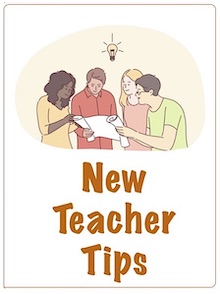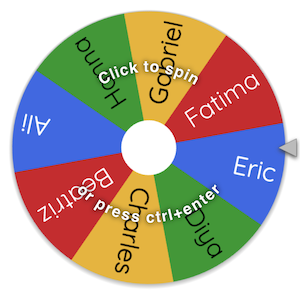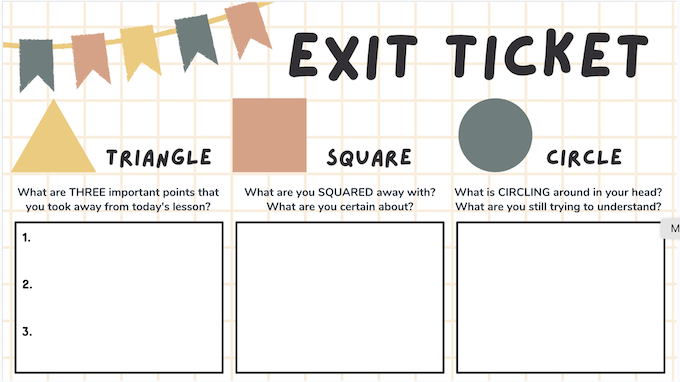Power Up the Learning in the Last Minutes of Class
A MiddleWeb Blog
 Don’t Leave Learning Unfinished
Don’t Leave Learning Unfinished
Where I currently live, mid-October typically marks the beginning of rough winter weather. As a result, I’ve been spending evenings in my garage with the intent of getting it all cleaned up and “winterized.”
That includes rotating out warm-weather items that will get little use in the months to come. However, as I begin to pack and stack I always come across several unfinished projects, partially assembled items, and piles of haphazard tools. They all tell the same cautionary tale…be sure to finish what you started.
As teachers, we can fall into a similar trap by devoting all our time and energy to the beginning and middle of a lesson but failing to provide a meaningful closure. This is unfortunate because closure activities have the capacity to create sticky, powerful learning that endures long after the last bell of the day rings.
Here’s what we can do
When trying to design or find an effective routine to round out daily learning, educators can consider these suggestions:
● Work to emphasize key information.
● Determine what kind of knowledge (declarative, procedural, etc.) we want students to own when they leave.
● Invest time identifying and correcting misunderstandings.
● Check for understanding and gather information for future lesson planning.
● Use closure activities that create a lasting impression.
Favorites from veteran teachers
Veteran educators possess a wealth of experience and will have good suggestions about which closure strategies to use. Below are some ideas shared with me by my experienced colleagues, along with several I’ve recently observed teachers use successfully.
►Ranking: This works best with a series of items learned. Students think through a list of things learned in the lesson, rank them in importance in their view, then justify their choices. The rankings can then lead to small group or whole class discussions and/or debate.
►Brain dumps and retrieval practice: Have students write down everything they’ve learned in the lesson. Then have students circle their top 5, star their top 3, etc. Students can do this individually or in groups.
►Biggest takeaway: Simply ask students to write down and share what their biggest takeaway is for the day. Keep in mind that some similarity/repetition in student answers is okay.
►Reflection: A simple 2-3 item questionnaire/reflection can work. For example:
● Restate what you learned in simplest possible terms.
● How will you use this to improve your ability to ________ IN our class?
● How will you use this to do __________ OUTSIDE of the class?
►Exit tickets: Have students engage in reflection and self-assessment. See this example.
►Revisiting learning goals: Have students write down or state what the goals of the lesson/activity were and reflect on how well the goals were met in the lesson.
►Daily or weekly news report: Show students a sample news report script. Students then work to create a 30-second news segment script detailing what was learned during the lesson/week. Teachers can select a few samples each time the activity is done to share with students and for them to review later on.
►Explain it twice: Guided by the teacher (or independently), students turn to a partner and explain the most important things they have learned without looking at any materials used in class. Then give them a chance to review their notes, the teacher’s slides, etc., and ask them to explain talking points a second time. This time, however, they work to fill in anything they missed or got wrong.
►Partner questions: Having students turn to a partner and ask two questions they now have and want to know more about based on the lesson.
►Design a model: Students take information learned and model it in some way – graphic organizer, chart, picture, cartoon, other drawing – and then explain the design and meaning of what they have created to someone else.
My personal favorites
In addition to the suggestions above, some of my favorite ways to wrap up a lesson include:
►Thinking routines. Try I used to think, but now I think. In this activity, students reflect on their thinking about a topic or issue and explore how and why their thinking has changed. It helps consolidate new learning.
►Clear as mud. Ask students what the clearest and muddiest point is that was addressed during our time together.
►Everybody thinking. My thoughts, others’ thoughts, new thoughts is another fun way to formulate and share new insights with classmates.

►Slide out of the room. Before they leave, ask students to create one or two study slides that combine verbal and visual info for us to review later on.
►A different calling. Instead of cold calling, try Warm Calling students. Give them time to discuss and prepare answers to guiding questions before pulling students’ names from popsicle sticks or spinning the Wheel of Destiny.
Student suggestions
Learners are also incredible sources of what works for them at the end of a lesson. And they like closure.
When I visited with a number of students in recent weeks, I asked about end-of-class learning. It was apparent that they find closure activities helpful for summarizing, reviewing, demonstrating their understanding of major points, consolidating and internalizing key information, linking lesson ideas to a conceptual framework and/or previously learned knowledge, and transferring ideas to new situations.
Here some favorite activities, other suggestions, and general comments offered up by students:
● “I enjoyed it when we created “cheat sheets” of everything that students in the class would need to know from the day.”
● “I really like when our teacher asks a few of us to demonstrate what was learned in a skit or explain whatever the topic was in our own words.”
● “Exit tickets give me a chance to remember what it is we were supposed to be learning and tell my teacher what I am still struggling with.”
● “Review games are more fun than a lot of the stuff we do. I still like Kahoot and some of the other game quizzes.”
● “I like team competitions (race for the right answer, Jeopardy, etc.).”
● “I don’t really mind rapid-fire questions before the bell, as long as I know what the questions will be in advance and have time to get ready for them.”
● “Honestly, I like it when my teacher asks us… ‘Where are we ever going to use this outside of school?’ at the end of class. It reminds me that what we just did wasn’t a waste of time.”
● “Our class sometimes sketches pictures or emojis on what we have learned. Emojis can be more useful because students will see them when they text friends and family or post something on social media.”
● “Snowball Fight. My favorite teacher has us write down an important thing that we learned, crumple it into a ball, and throw it high in the air. Each of us then picks a random ball off the floor and discusses it with a group or the class.”
● “A couple of times we did this thing called DJ Summary. We had to write what we learned to the tune of a favorite song and got something cool if we sang and explained it to someone else.”
Conclusion
Winter looms and so does the need to tidy up my garage and complete the projects I’d left unfinished. It’s the only way I and my family will be ready for what’s next. The same goes for students in our classrooms.
“Finishing What We Started” in education involves not just concluding a lesson but ensuring that the knowledge resonates and endures. We need to remember that the lasting impact is forged in the conclusion and invest some time in that – so we make sure we pave the way for future learning.
References
Aktekin, N. A. F. İ. Y. E., Çelebi, H., & Aktekin, M. (2018). Let’s Kahoot! anatomy utilicemos Kahoot! anatomía. International Journal of Morphology, 36(2) at https://avesis.acibadem.edu.tr/yayin/91410bbb-c0b0-4e1d-bb10-9d3571aee3f3/lets-kahoot-anatomy-utilicemos-kahoot-anatomia/document.pdf on page 718
Lucero, R. (2006). Closure activities: Making that last impression.
Feature image by Gerd Altmann from Pixabay



































Nice job!! These are wonderful reminders of how we can actively help our students remember what they have learned and helps us stay on our toes as teachers.
What an excellent array of ideas to help students solidify their thinking and ask questions they may still have. I love these. Thanks, Curtis!